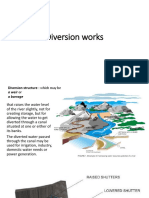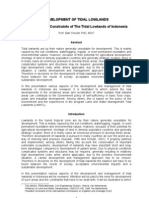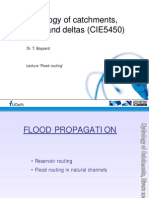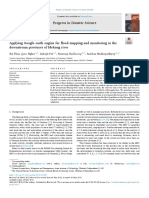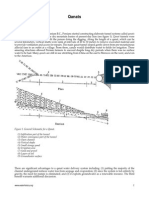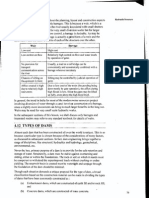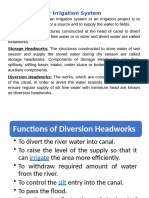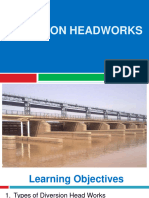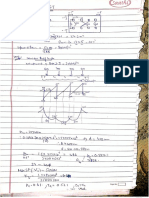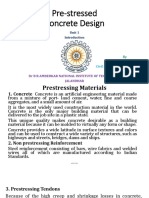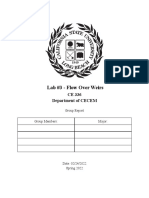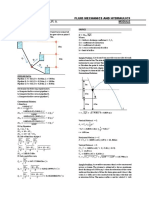0 ratings0% found this document useful (0 votes)
129 viewsDiversion Head Works
Diversion Head Works
Uploaded by
Nikhil PhulHeadworks are hydraulic structures that supply water to canals. There are two types: (1) storage headworks, which use dams to form reservoirs; and (2) diversion headworks, which use weirs or barrages across rivers to divert water into canals. Diversion headworks raise water levels and regulate flows into canals, while controlling silt and fluctuating water levels. Their components include weirs/barrages, undersluices, divide walls, fish ladders, and canal head regulators. Proper site selection and river training works are also important.
Copyright:
© All Rights Reserved
Available Formats
Download as PDF, TXT or read online from Scribd
Diversion Head Works
Diversion Head Works
Uploaded by
Nikhil Phul0 ratings0% found this document useful (0 votes)
129 views63 pagesHeadworks are hydraulic structures that supply water to canals. There are two types: (1) storage headworks, which use dams to form reservoirs; and (2) diversion headworks, which use weirs or barrages across rivers to divert water into canals. Diversion headworks raise water levels and regulate flows into canals, while controlling silt and fluctuating water levels. Their components include weirs/barrages, undersluices, divide walls, fish ladders, and canal head regulators. Proper site selection and river training works are also important.
Original Description:
Jsjdj
Copyright
© © All Rights Reserved
Available Formats
PDF, TXT or read online from Scribd
Share this document
Did you find this document useful?
Is this content inappropriate?
Headworks are hydraulic structures that supply water to canals. There are two types: (1) storage headworks, which use dams to form reservoirs; and (2) diversion headworks, which use weirs or barrages across rivers to divert water into canals. Diversion headworks raise water levels and regulate flows into canals, while controlling silt and fluctuating water levels. Their components include weirs/barrages, undersluices, divide walls, fish ladders, and canal head regulators. Proper site selection and river training works are also important.
Copyright:
© All Rights Reserved
Available Formats
Download as PDF, TXT or read online from Scribd
Download as pdf or txt
0 ratings0% found this document useful (0 votes)
129 views63 pagesDiversion Head Works
Diversion Head Works
Uploaded by
Nikhil PhulHeadworks are hydraulic structures that supply water to canals. There are two types: (1) storage headworks, which use dams to form reservoirs; and (2) diversion headworks, which use weirs or barrages across rivers to divert water into canals. Diversion headworks raise water levels and regulate flows into canals, while controlling silt and fluctuating water levels. Their components include weirs/barrages, undersluices, divide walls, fish ladders, and canal head regulators. Proper site selection and river training works are also important.
Copyright:
© All Rights Reserved
Available Formats
Download as PDF, TXT or read online from Scribd
Download as pdf or txt
You are on page 1of 63
Introduction…
Any hydraulic structure which supplies water to
the off-taking canal is called a headwork.
Headwork may be divided into two
1. Storage headwork.
2. Diversion headwork.
Storage head works
Dam is constructed across a river valley to
form storage reservoir, known as storage head
works.
Water is supplied to the canal from this
reservoir through canal regulator.
These serves for multipurpose function like
hydro- electric power generation, flood control,
fishery.
Diversion head works
Weir or barrage is constructed across a
perennial river to raise water level and to divert
the water to canal, is known as diversion head
work.
Flow of water in the canal is controlled by
canal head regulator.
Objective of diversion head work
It raises the water level on its upstream side.
It regulates the supply of water into canals.
It controls the entry of silt into canals
It creates a small pond (not reservoir) on its
upstream and provides some pondage.
It helps in controlling the fluctuation of water
level in river during different seasons.
Site selection for diversion head work
The river section at the site should be narrow
and well-defined.
The river should have high, well-defined, in
erodible and non-submersible banks so that the
cost of river training works is minimum.
The canals taking off from the diversion head
works should be quite economical and
Should have a large commanded area.
There should be suitable arrangement for the
diversion of river during construction.
The site should be such that the weir (or
barrage) can be aligned at right angles to the
direction of flow in the river.
There should be suitable locations for the
under sluices, head regulator and other
components of the diversion head works.
The diversion head works should not
submerge costly land and property on its
upstream.
Good foundation should be available at the
site.
The required materials of construction should
be available near the site.
The site should be easily accessible by road or
rail.
The overall cost of the project should be a
minimum.
Components of a diversion headwork
Weir or barrage
Undersluices
Divide wall
Fish ladder
Canal head regulator
Silt excluders/ Silt prevention devices
River training works (Marginal bunds and
guide banks)
Weir
Normally the water level of any perennial river is such
that it cannot be diverted to the irrigation canal.
The bed level of the canal may be higher than the
existing water level of the river.
In such cases weir is constructed across the river to
raise the water level.
Surplus water pass over the crest of weir.
Adjustable shutters are provided on the crest to raise
the water level to some required height.
Barrage
When the water level on the up stream side of
the weir is required to be raised to different
levels at different time, barrage is constructed.
Barrage is an arrangement of adjustable gates
or shutters at different tires over the weir.
Barrage Weir
Low set crest High set crest
Ponding is done by means of gates Ponding is done against the raised
crest or partly against crest and partly
by shutters
Gated over entire length Shutters in part length
Gates are of greater height Shutters are of smaller height, 2 m
Perfect control on river flow No control of river in low floods
High floods can be passed with Excessive afflux in high floods
minimum afflux
Less silting upstream due to low set Raised crest causes silting upstream
crest
Longer construction period Shorter construction period
Silt removal is done through under No means for silt disposal
sluices
Costly structure Relatively cheaper structure
Under sluices
Also known as scouring sluices.
The under sluices are the openings provided
at the base of the weir or barrage.
These openings are provided with adjustable
gates. Normally, the gates are kept closed.
The suspended silt goes on depositing in front
of the canal head regulator.
When the silt deposition becomes appreciable
the gates are opened and the deposited silt is
loosened with an agitator mounting on a boat.
The muddy water flows towards the
downstream through the scouring sluices.
The gates are then closed. But, at the period
of flood, the gates are kept opened.
Divide wall
The divide wall is a long wall constructed at
right angles in the weir or barrage, it may be
constructed with stone masonry or cement
concrete.
On the upstream side, the wall is extended just
to cover the canal head regulator and on the
downstream side, it is extended up to the
launching apron.
The functions of the divide wall are as follows:
To form a still water pocket in front of the canal head
so that the suspended silt can be settled down which
then later be cleaned through the scouring sluices from
time to time.
It controls the eddy current or cross current in front
of the canal head.
It provides a straight approach in front of the canal
head.
It resists the overturning effect on the weir or barrage
caused by the pressure of the impounding water.
Fish ladder
The fish ladder is provided just by the side of the
divide wall for the free movement of fishes.
Rivers are important source of fishes.
The tendency of fish is to move from upstream to
downstream in winters and from downstream to
upstream in monsoons.
This movement is essential for their survival.
Due to construction of weir or barrage, this
movement gets obstructed, and is detrimental to
the fishes.
In the fish ladder, the fable walls are constructed in
a zigzag manner so that the velocity of flow within
the ladder does not exceed 3 m/sec.
The width, length and height of the fish ladder
depend on the nature of the river and the type of
the weir or barrage.
Canal head regulator
A structure which is constructed at the head of
the canal to regulate flow of water is known as
canal head regulator.
It consists of a number of piers which divide
the total width of the canal into a number of
spans which are known as bays.
The piers consist of number tiers on which the
adjustable gates are placed.
The gates are operated form the top by suitable
mechanical device.
A platform is provided on the top of the piers
for the facility of operating the gates.
Again some piers are constructed on the down
stream side of the canal head to support the
roadway.
Functions of Canal Head Regulator
It regulates the supply of water entering the
canal
It controls the entry of silt in the canal
It prevents the river-floods from entering the
canal
Silt regulation works
The entry of silt into a canal, which takes off
from a head works, can be reduced by
constructed certain special works, called silt
control works.
These works may be classified into the
following two types:
(a) Silt Excluders
(b) Silt Ejectors
Silt Excluders
Silt excluders are those works which are
constructed on the bed of the river, upstream of
the head regulator.
The clearer water enters the head regulator
and silted water enters the silt excluder.
In this type of works, the silt is, therefore,,
removed from the water before in enters the
canal.
Silt Ejectors
Silt ejectors, also called silt extractors, are those
devices which extract the silt from the canal
water after the silted water has travelled a
certain distance in the off-take canal.
These works are, therefore, constructed on the
bed of the canal, and little distance downstream
from the head regulator.
River training works
River training works are required near the weir site in
order to ensure a smooth and an axial flow of water,
and thus, to prevent the river from outflanking the
works due to a change in its course.
The river training works required on a canal headwork
are:
(a) Guide banks
(b) Marginal bunds
(c) Spurs or groynes
Guide Bank
When a barrage is constructed across a river which
flows through the alluvial soil, the guide banks must
be constructed on both the approaches to protect the
structure from erosion.
Guide bank serves the following purposes:
It protects the barrage from the effect of scouring and
erosion.
It provides a straight approach towards the barrage.
It controls the tendency of changing the course of the
river.
It controls the velocity of flow near the structure.
Marginal Bunds
The marginal bunds are earthen embankments
which are constructed parallel to the river bank
on one or
both the banks according to the condition. The
top width is generally 3 m to 4 m. The side
slope on the
river side is generally 1.5: 1 and that on the
country side is 2:1.
The marginal bunds serve the following
purposes:
It prevents the flood water or storage water
from entering the surrounding area which may
be submerged or may be water logged.
It retains the flood water or storage water within
a specified section.
It protects the towns and villages from
devastation during the heavy flood.
It protects valuable agricultural lands.
Causes of failure of structure
Irrigation structures (or hydraulic structures)
for the diversion and distribution works are
weirs, barrages, head regulators, distributary
head regulators, cross regulators, cross-drainage
works, etc.
These structures are generally founded on
alluvial soils which are highly pervious.
These soils are easily scoured when the high
velocity water passes over the structures.
The failures of weirs constructed on the
permeable foundation may occur due to
various causes, which may be broadly classified
into the following two categories:
1. Failure due to- subsurface flow
2. Failure due to surface flow
1. Failure due to- subsurface flow
(a) Failure by Piping or undermining
water from the upstream side continuously percolates
through the bottom of the foundation and emerges at
the downstream end of the weir or barrage floor.
The force of percolating water removes the soil
particles by scouring at the point of emergence.
As the process of removal of soil particles goes on
continuously, a depression is formed which extends
backwards towards the upstream through the bottom
of the foundation.
A hollow pipe like formation thus develops
under the foundation due to which the weir or
barrage may fail by subsiding.
This phenomenon is known as failure by
piping or undermining.
(b) Failure by Direct uplift
The percolating water exerts an upward
pressure on the foundation of the weir or
barrage.
If this uplift pressure is not counterbalanced by
the self weight of the structure, it may fail by
rapture.
2. Failure due to- surface flow
(a) By hydraulic jump
When the water flows with a very high velocity
over the crest of the weir or over the gates of
the barrage, then hydraulic jump develops.
This hydraulic jump causes a suction pressure
or negative pressure on the downstream side
which acts in the direction uplift pressure.
If the thickness of the impervious floor is
sufficient, then the structure fails by rapture.
(b) By scouring
During floods, the gates of the barrage are kept
open and the water flows with high velocity.
The water may also flow with very high velocity
over the crest of the weir.
Both the cases can result in scouring effect on
the downstream and on the upstream side of
the structure.
Due to scouring of the soil on both sides of the
structure, its stability gets endangered by
shearing.
Design aspects
(a)Subsurface flow
1. The structure should be designed such that the
piping failure does not occur due to subsurface
flow.
2. The downstream pile must be provided to
reduce the exit gradient and to prevent piping.
3. An impervious floor of adequate length is
provided to increase the path of percolation
and to reduce the hydraulic gradient and the
seepage force.
4. The seepage path is increased by providing
piles and impervious floor to reduce the uplift
pressure.
5. The thickness of the floor should be sufficient
to resist the uplift pressure due to subsurface
flow.
6. A suitably graded inverted filter should be
provided at the downstream end of the
impervious floor to check the migration of soil
particles along with water. The filter layer is
loaded with concrete blocks.
(b) Surface flow
1. The piles (or cut-off walls) at the upstream and
downstream ends of the impervious floor
should be provided upto the maximum scour
level to protect the main structure against scour.
2. The launching aprons should be provided at
the upstream and downstream ends to provide
a cover to the main structure against scour.
3. A device is required at the downstream to
dissipate energy. For large drops, hydraulic
jump is used to dissipate the energy.
4. Additional thickness of the impervious floor is
provided at the point where the hydraulic jump
is formed to counterbalance the suction
pressure.
5. The floor is constructed as a monolithic
structure to develop bending resistance (or
beam action) to resist the suction pressure.
Khosla’s theory
Many of the important hydraulic structures,
such as weirs and barrage, were designed on the
basis of
Bligh’s theory between the periods 1910 to
1925.
In 1926 – 27, the upper Chenab canal siphons,
designed on Bligh’s theory, started posing
undermining troubles.
Investigations started, which ultimately lead to
Khosla’s theory.
Following are some of the main points
from Khosla's Theory.
1. Outer faces of end sheet piles were much
more effective than the inner ones and the
horizontal length of the floor.
2. Intermediated piles of smaller length were
ineffective except for local redistribution of
pressure.
3. Undermining of floor started from tail end.
4. It was absolutely essential to have a reasonably
deep vertical cut off at the downstream end to
prevent undermining.
5. Khosla and his associates took into account the
flow pattern below the impermeable base of
hydraulic structure to calculate uplift pressure
and exit gradient.
6. Seeping water below a hydraulic structure does
not follow the bottom profile of the impervious
floor as stated by Bligh but each particle traces
its path along a series of streamlines.
Method of independent variable
Most designs do not confirm to elementary
profiles (specific cases).
In actual cases we may have a number of piles
at upstream level, downstream level and
intermediate points and the floor also has some
thickness.
Khosla solved the actual problem by an
empirical method known as method of
independent variables.
This method consists of breaking up a complex
profile into a number of simple profiles, each of
which is independently amiable to mathematical
treatment.
Then apply corrections due to thickness of
slope of floor.
As an example the complex profile shown in fig
is broken up to the following simple profile and
the pressure at Key Points obtained.
Straight floor of negligible thickness with pile at
upstream ends.
Straight floor of negligible thickness with pile at
downstream end.
Straight floor of negligible thickness with pile at
intermediate points.
The pressure is obtained at the key points by
considering the simple profile.
For the determination of seepage below the
foundation of hydraulic structure developed the
method of independent variable.
In this method, the actual profile of a weir which is
complex, is divided into a number simple profiles,
each of which cab be solved mathematically without
much difficulty.
The most useful profile considered are:
(i) A straight horizontal floor of negligible thickness
provided with a sheet pile at the upstream end or a
sheet pile at the downstream end.
(ii) A straight horizontal floor depressed below the bed,
but without any vertical cut-off.
Intermediate point
The mathematical solution of the flow-nets of the
above profiles have been given in the form of curves.
From the curves, percentage pressures at various key
points E, C be determined. The important points to
note are:
Junctions of pile with the floor on either side{E, C
(bottom), E1, C1 (top) }
Bottom point of the pile (D), and
Junction of the bottom corners (D, D’) in case of
depressed floor
The percentage pressures at the key points of a
simple forms will become valid for any complex profile,
provided the following corrections are effected:
correction for mutual interference of piles
correction for the thickness of floor
correction for slope of the floor.
Correction for Mutual Interference of Piles
Let b1 = distance between the two piles 1 and
2, and
D = the depth of the pile line (2), the influence
of which on the neighbouring pile (1) of depth
d must be determined
b = total length of the impervious floor
c = correction due to interference.
The correction is applied as a percentage of
the head
This correction is positive when the point is considered
to be at the rear of the interfering pile and negative for
points considered in the forward or flow direction with
the interfering pile.
Correction for Floor Thickness
Standard profiles assuming the floors as having
negligible thickness.
Hence the values of the percentage pressures
computed from the curves corresponds to the top
levels (E1*, C1*) of the floor.
However, the junction points of the floor and pile are
at the bottom of the floor (E1, C1)
The pressures at the actual points E1 and C1
are interpolated by assuming a straight line
variation in pressures from the points E1* to
D1 and from D1 to C1.
The corrected pressures at E1 should be less
than the computed pressure t E1*. Therefore
the correction for the pressure at E1 will be
negative. And so also is for pressure at C1.
Correction for Slope of Floor
A correction for a sloping impervious floor is
positive for the down slope in the flow direction
and negative for the up slope in the direction of
flow.
The correction factor must be multiplied by
the horizontal length of the slope and divided
by the distance between the two poles between
which the sloping floor exists.
Exit gradient (GE)
It has been determined that for a standard
form consisting of a floor length (b) with a
vertical cut-off of depth (d), the exit gradient at
its downstream end is given by:
Values of safe exit gradient may be
taken as:
0.14 to 0.17 for fine sand
0.17 to 0.20 for coarse sand
0.20 to 0.25 for shingle
You might also like
- Hydraulic StructureDocument4 pagesHydraulic StructureRustom RemorozaNo ratings yet
- HC Weir ManualDocument60 pagesHC Weir ManualLakshmi Kantha100% (1)
- Asset - Inspection - Procedures Standard Inspection UnitDocument100 pagesAsset - Inspection - Procedures Standard Inspection UnitMohamed Abbas100% (1)
- 1135 PDFDocument464 pages1135 PDFsomu100% (1)
- Diversionheadworkm3 120625052707 Phpapp02Document66 pagesDiversionheadworkm3 120625052707 Phpapp02Manikanta ReddyNo ratings yet
- Diversion Head Works: Prepared by Bibhabasu Mohanty Dept. of Civil EngineeringDocument66 pagesDiversion Head Works: Prepared by Bibhabasu Mohanty Dept. of Civil EngineeringhNo ratings yet
- Diversion Headworks: CEL351: Design of Hydraulic StructuresDocument78 pagesDiversion Headworks: CEL351: Design of Hydraulic StructuresAlvaro Rodrigo Chavez Viveros100% (1)
- Diversion WorksDocument84 pagesDiversion WorksIzet Mehmetaj100% (1)
- Design of Hydraulic WorksDocument22 pagesDesign of Hydraulic WorksMariano Jesús Santa María CarlosNo ratings yet
- About Chute SpillwayDocument15 pagesAbout Chute SpillwayPrem Singh RawatNo ratings yet
- SCADA System For Surface Water Resource Audit in TDocument6 pagesSCADA System For Surface Water Resource Audit in Tfaisal yousafNo ratings yet
- Salas (Maidment) - 1993. Analysis and Modeling of Hydrologic Time SeriesDocument63 pagesSalas (Maidment) - 1993. Analysis and Modeling of Hydrologic Time Seriesautobahn8912No ratings yet
- Development of Tidal Lowlands in IndonesiaDocument17 pagesDevelopment of Tidal Lowlands in IndonesiaMuharruddin100% (1)
- Installation of Telemetry Network For The Modernizaton of Irrigation System in PakistanDocument10 pagesInstallation of Telemetry Network For The Modernizaton of Irrigation System in Pakistanfarhan100% (1)
- Lin in G of Irrigatio N Can Als An D Econ Omics of Lin Ing: Chapter No. 5 Santosh KumarDocument26 pagesLin in G of Irrigatio N Can Als An D Econ Omics of Lin Ing: Chapter No. 5 Santosh KumarUmer Waheed100% (1)
- CVNG 2003-Design II Culvert DesignDocument69 pagesCVNG 2003-Design II Culvert Designrajal11No ratings yet
- Hydraulic Structures For Flow Diversion and StorageDocument25 pagesHydraulic Structures For Flow Diversion and StorageEndless LoveNo ratings yet
- Water Resources Management in A Changing WorldDocument6 pagesWater Resources Management in A Changing Worldbolistipo717No ratings yet
- DIVERSION-HEADWORKS and Seepage Theories-SlidesDocument93 pagesDIVERSION-HEADWORKS and Seepage Theories-SlidesUmesh RegmiNo ratings yet
- Lining CanalDocument39 pagesLining CanalAastha SoniNo ratings yet
- Prosiding WetlandDocument420 pagesProsiding WetlandMuchtar LubisNo ratings yet
- Canal RegulatorsDocument27 pagesCanal Regulatorssaamy100% (2)
- Flip Bucket ManualDocument69 pagesFlip Bucket ManualMalik BilalNo ratings yet
- Chapter 6 Fishways PDFDocument6 pagesChapter 6 Fishways PDFFarid Ahmad ShalahuddinNo ratings yet
- Lectures 5 Design RegulatorDocument22 pagesLectures 5 Design RegulatorJai Singh RathorNo ratings yet
- Design of Silt Excluders (India)Document12 pagesDesign of Silt Excluders (India)jethro_012100% (1)
- Dam DesignDocument48 pagesDam DesignPride MatengaNo ratings yet
- Diversion Head Work: Prof. M.B Chougule DKTE' YCP IchalkaranjiDocument63 pagesDiversion Head Work: Prof. M.B Chougule DKTE' YCP Ichalkaranjishamsu100% (2)
- CIE5450 Hydrology Flood Routing Part2 PDFDocument20 pagesCIE5450 Hydrology Flood Routing Part2 PDFJohn E Cutipa L100% (1)
- Applying Google Earth Engine For Flood Mapping and Monit - 2022 - Progress in DiDocument11 pagesApplying Google Earth Engine For Flood Mapping and Monit - 2022 - Progress in DiHiền TrầnNo ratings yet
- Cross Drainage Works - 29052016Document30 pagesCross Drainage Works - 29052016Md Raihan Ali100% (1)
- Zakho, Iraq Travel Weather Averages (Weatherbase)Document4 pagesZakho, Iraq Travel Weather Averages (Weatherbase)gazi shaikhNo ratings yet
- QanatsDocument7 pagesQanatsAman Jot SinghNo ratings yet
- Types of Dams Storage StructuresDocument4 pagesTypes of Dams Storage StructuresRaju ShresthaNo ratings yet
- Canal Outlets and Canal RegulationsDocument22 pagesCanal Outlets and Canal RegulationssatyaNo ratings yet
- 1877 PDFDocument8 pages1877 PDFAhmed AlbayatiNo ratings yet
- Rice IrrigationDocument40 pagesRice IrrigationAndrew ReidNo ratings yet
- Hydraulic Structures - FloodsDocument28 pagesHydraulic Structures - Floodsvamsi_rs100% (1)
- Civil Engineering Practice (CE-203)Document31 pagesCivil Engineering Practice (CE-203)AliNo ratings yet
- Hydraulics Training Lesson 10Document22 pagesHydraulics Training Lesson 10sponky05100% (1)
- Reservoir SedimentationDocument8 pagesReservoir Sedimentationmiguelangel1986100% (1)
- Gravity Fed SchemesDocument8 pagesGravity Fed SchemesAnita0% (1)
- Chap 7&8Document59 pagesChap 7&8ingenzihubertNo ratings yet
- Hydraulic Structures - An IntroductionDocument41 pagesHydraulic Structures - An Introductiondeepak_ram_5100% (1)
- Weir - Vertical Drop: Customer InformationDocument2 pagesWeir - Vertical Drop: Customer InformationVinay ChandwaniNo ratings yet
- Balochistan's Water SectorDocument117 pagesBalochistan's Water SectorXulfi AliNo ratings yet
- Unit 1 - Canal DesignDocument75 pagesUnit 1 - Canal DesignAshwini Nair100% (1)
- Stability Analysis of Earth Dam by GeostudioDocument10 pagesStability Analysis of Earth Dam by GeostudioIAEME PublicationNo ratings yet
- Lecture # 01. Introduction, Water Resources, & Irrigation.Document64 pagesLecture # 01. Introduction, Water Resources, & Irrigation.Muhammad UsmanNo ratings yet
- Water Resources Systems Planning and Management: Chapter TwoDocument69 pagesWater Resources Systems Planning and Management: Chapter TwoAbdirahman aliNo ratings yet
- Causes of Failures of Earth DamDocument12 pagesCauses of Failures of Earth DamdevendarNo ratings yet
- ANNEXURE VBDocument16 pagesANNEXURE VBCIDCONMIA.COMNo ratings yet
- Manual on Climate Change Adjustments for Detailed Engineering Design of Roads Using Examples from Viet NamFrom EverandManual on Climate Change Adjustments for Detailed Engineering Design of Roads Using Examples from Viet NamNo ratings yet
- Climate Change Adjustments for Detailed Engineering Design of Roads: Experience from Viet NamFrom EverandClimate Change Adjustments for Detailed Engineering Design of Roads: Experience from Viet NamNo ratings yet
- DiversionheadworkDocument47 pagesDiversionheadworksuprajaNo ratings yet
- Diversion Head WorkDocument6 pagesDiversion Head WorkShahid RøckzzNo ratings yet
- Diversion Head WorksDocument48 pagesDiversion Head Worksprashanthreddyh100% (6)
- HeadworkDocument35 pagesHeadworkqureshixahoorNo ratings yet
- Diversion HeadworksDocument24 pagesDiversion HeadworksShankar ShaudNo ratings yet
- 8 B Diversion HeadworksDocument35 pages8 B Diversion HeadworksKika CalafatNo ratings yet
- Chapter 7 Diversion WeirsDocument36 pagesChapter 7 Diversion WeirsMohamoud Abdulahi100% (1)
- Office Order (11 20051192524Document1 pageOffice Order (11 20051192524Nikhil PhulNo ratings yet
- Job Description - REG (RPMG)Document1 pageJob Description - REG (RPMG)Nikhil PhulNo ratings yet
- NNFL CheatDocument2 pagesNNFL CheatNikhil PhulNo ratings yet
- Raft NumericalDocument2 pagesRaft NumericalNikhil PhulNo ratings yet
- Shallow Foundations-Frhnn For Minor1Document47 pagesShallow Foundations-Frhnn For Minor1Nikhil PhulNo ratings yet
- Unit 1 PPT AK 7th Sem PDFDocument31 pagesUnit 1 PPT AK 7th Sem PDFNikhil PhulNo ratings yet
- C8h0vm00009r4svu PDFDocument179 pagesC8h0vm00009r4svu PDFNikhil PhulNo ratings yet
- Cse PDFDocument55 pagesCse PDFNikhil PhulNo ratings yet
- 150609b TBS Authoring FAQ PDFDocument4 pages150609b TBS Authoring FAQ PDFNikhil PhulNo ratings yet
- Lec 10 SleepersDocument7 pagesLec 10 SleepersNikhil PhulNo ratings yet
- Lec 7 CreepDocument3 pagesLec 7 CreepNikhil PhulNo ratings yet
- Wears and Failures in Rails: Chapter-8Document5 pagesWears and Failures in Rails: Chapter-8Nikhil PhulNo ratings yet
- What Is Canal Fall?Document26 pagesWhat Is Canal Fall?Nikhil PhulNo ratings yet
- DR B R Ambedkar National Institute of Technology G T Road Bye Pass, Jalandhar-144011, Punjab (India)Document2 pagesDR B R Ambedkar National Institute of Technology G T Road Bye Pass, Jalandhar-144011, Punjab (India)Nikhil PhulNo ratings yet
- L&T Construction Heavy Civil Infrastructure - Edrc: Design of Supporting BeamDocument8 pagesL&T Construction Heavy Civil Infrastructure - Edrc: Design of Supporting BeamNikhil PhulNo ratings yet
- WR Lecture Notes 5 Water Resource Sediment TransportDocument48 pagesWR Lecture Notes 5 Water Resource Sediment TransportMouhamad Khaled AyachNo ratings yet
- Lab #3 - Flow Over WeirsDocument12 pagesLab #3 - Flow Over WeirsDeborah SongNo ratings yet
- Drop SpillwaysDocument174 pagesDrop SpillwaysHenry AlvarezNo ratings yet
- Fluid Lab Manual LatestDocument78 pagesFluid Lab Manual LatestZia Ur Rahman KhanNo ratings yet
- YANTAL Maso HOLYKELL Open Channel Flow Meter User ManualDocument38 pagesYANTAL Maso HOLYKELL Open Channel Flow Meter User ManualKevinCRomeroNo ratings yet
- 1386 PDFDocument436 pages1386 PDFAssitant Engineer Maganoor MandalNo ratings yet
- CE12 - Uplift Pressure Under Hydraulic StructuresDocument17 pagesCE12 - Uplift Pressure Under Hydraulic StructuresLawliet Lawford100% (1)
- 0-Syllabus N BooksDocument12 pages0-Syllabus N Bookswajid malikNo ratings yet
- OpDocument88 pagesOpMahmud Rahman BizoyNo ratings yet
- 10CV65 - Hydraulic Structures and Irrigation Design - Drawing Question BankDocument6 pages10CV65 - Hydraulic Structures and Irrigation Design - Drawing Question BankMr. Y. RajeshNo ratings yet
- Lab Flow Over WeirDocument13 pagesLab Flow Over WeirMd. FizNo ratings yet
- Ambala District Gazetteer, 1923-24: Gazetteers Organisation Revenue Department Haryana Chandigarh (India)Document153 pagesAmbala District Gazetteer, 1923-24: Gazetteers Organisation Revenue Department Haryana Chandigarh (India)Rajendra PrasadNo ratings yet
- Weir DesignDocument42 pagesWeir DesignKevin John VelascoNo ratings yet
- Drainage Design GuideDocument15 pagesDrainage Design Guidesent TNo ratings yet
- Quench Tower PerhitunganDocument7 pagesQuench Tower PerhitunganRizqia Putri ZakkaNo ratings yet
- Cecw-Ed-D Engineer Manual 1110-2-1603 U.S. Army Corps of Engineers EM 1110-2-1603 16 January 1990 (Original) 31 August 1992 (Errata #1)Document170 pagesCecw-Ed-D Engineer Manual 1110-2-1603 U.S. Army Corps of Engineers EM 1110-2-1603 16 January 1990 (Original) 31 August 1992 (Errata #1)ayman_awadallahNo ratings yet
- A Swot Analysis of Hydrodynamic Models With Respect To Simulating BreachingDocument8 pagesA Swot Analysis of Hydrodynamic Models With Respect To Simulating BreachingStanislav KotaškaNo ratings yet
- Submerged Labyrinth WeirsDocument8 pagesSubmerged Labyrinth WeirsEric ChanNo ratings yet
- Dominic Et Al. (2019) Computational Investigation of Hydraulic PerformanceDocument11 pagesDominic Et Al. (2019) Computational Investigation of Hydraulic PerformanceCarlos Arturo Gomez JimenezNo ratings yet
- 10.open ChannelDocument23 pages10.open ChannelNani DeramanNo ratings yet
- 131305-130602-Fluid Mechanics PDFDocument2 pages131305-130602-Fluid Mechanics PDFrishabhk28995No ratings yet
- Hydraulics Module CDocument5 pagesHydraulics Module ChazelNo ratings yet
- Studi Gerusan Di Hilir Bendung Kolam Olak Tipe Vlughter Dengan Perlindungan GroundsillDocument11 pagesStudi Gerusan Di Hilir Bendung Kolam Olak Tipe Vlughter Dengan Perlindungan GroundsillKelvin EnricoNo ratings yet
- Entrainment and Maximum Vapour Flow Rate of Trays: Arnold H. Van Sinderen, E. Frank Wijn and R.W. Jeroen ZantingDocument28 pagesEntrainment and Maximum Vapour Flow Rate of Trays: Arnold H. Van Sinderen, E. Frank Wijn and R.W. Jeroen ZantingdonyaNo ratings yet
- DIVERSION Head WorksDocument13 pagesDIVERSION Head WorksKalidas A KNo ratings yet
- PhillawDocument4 pagesPhillawmishiruNo ratings yet







